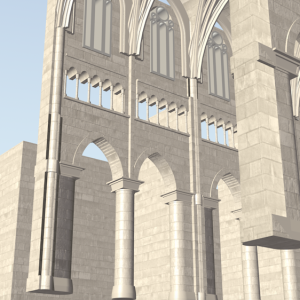Sainte-Catherine du Val des Écoliers
Jemma Armi, Saif Radi, Jonah Nelson, and Arianna Rivera
L’Université de Paris, built and dedicated a priory to St. Catherine to commemorate the victory of King Phillip II of France (1180-1223) in the Battle of Bouvines of 1214. The order did not receive subsidies until the reign of King Louis IX (1226-1270). The monarch, who referred to Sainte-Catherine du Val des Écoliers as his “Eldest Daughter,” ceremoniously laid the first stone in 1229, and visited the priory throughout his reign. Louis IX was commemorated as the priory’s founder in mural and sculpture. The Écoliers left the priory in 1767 after purchasing the Professed House after the Suppression of the Jesuits in 1764. Sainte-Catherine, deserted and in ruins, was destroyed. In present day Paris, the location of the priory now contains a plaza called Place du marché Sainte-Catherine in the Marais district, within the 4e arrondissement.
Selected Bibliography
Cohen, Meredith. “The Making Of A Royal City, Paris And The Architecture Of Philip Augustus.” The Sainte-Chapelle and the Construction of Sacral Monarchy: Royal Architecture in Thirteenth-century Paris. New York: Cambridge UP, 2015. 14-65. Print.
________. “Louis’ Later Patronage in Paris,” in The SainteChapelle and the Construction of Sacral Monarchy: Royal Architecture in ThirteenthCentury Paris (New York: Cambridge UP, 2014), 171194.
Guyon, Catherine and Michel Bur, L’ordre Du Val Des EÌcoliers (12011539), S.l.: S.n., 1996, 201247.
Hoffbauer, Edouard Fournier, A. Bonnardot, Jules Cousin, Alfred Franklin, Valentin Dufour, P. L. Jacob, L. M. Tisserand, Charles Jourdain, Édouard Drumont, and Albert Lenoir. “Le Temple, La Place Royale Et Le Marias.” Paris à Travers Les âges: Aspects Successifs Des Monuments Et Quartiers Historiques De Paris Depuis Le XIIIe Siècle Jusqu’à Nos Jours. 2. éd. ed. Paris: Librairied De Firmin-Didot Et Ce, 1885. 585-630. Print. UCLA YRL Special Collection.
Raunié, Émile. Épitaphier du vieux Paris







